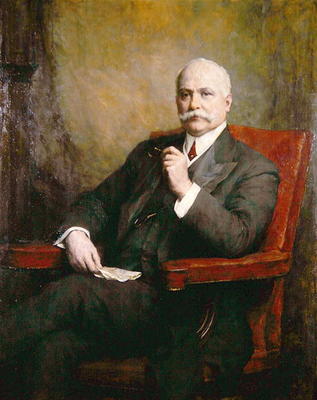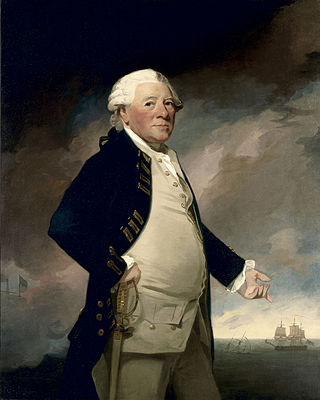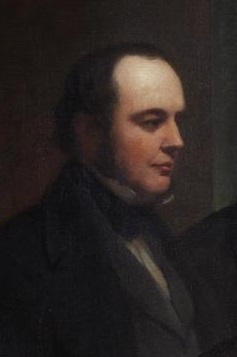
Earl of Lonsdale is a title that has been created twice in British history, firstly in the Peerage of Great Britain in 1784, and then in the Peerage of the United Kingdom in 1807, both times for members of the Lowther family.

Baron Rothschild, of Tring in the County of Hertfordshire, is a title in the Peerage of the United Kingdom. It was created in 1885 for Sir Nathan Rothschild, 2nd Baronet, a member of the Rothschild banking family. He was the first Jewish member of the House of Lords not to have previously converted to Christianity. The current holder of the title is Nathaniel Rothschild, 5th Baron Rothschild, who inherited the barony in February 2024.
The Meysey-Thompson Baronetcy, of Kirby Hall in the County of York, was a title in the Baronetage of the United Kingdom. It was created on 26 March 1874 for Harry Meysey-Thompson, Liberal member of parliament for Whitby. He was succeeded by his son, the second Baronet. He was a Liberal, and later Liberal Unionist politician. On 26 December 1905 he was created Baron Knaresborough, of Kirby Hall in the County of York, in the Peerage of the United Kingdom. The barony became extinct on his death in 1929 while the baronetcy survived. The presumed fourth Baronet never successfully proved his succession and was never on the Official Roll of the Baronetage. When he died in 2002 the baronetcy became extinct as well.

There have been three baronetcies created for persons with the surname Holden, all in the Baronetage of the United Kingdom. Two of the creations are extant as of 2010.

There have been two baronetcies created for members of the Dashwood family, one in the Baronetage of England and one in the Baronetage of Great Britain. Both creations are extant as of 2008.
There have been two baronetcies created for persons with the surname Adam, both in the Baronetage of the United Kingdom. One creation is extant as of 2009.
There have been two baronetcies created for people with the surname Heathcote, both in the Baronetage of Great Britain and both created in 1733. The holders of the first creation were later elevated to the peerage as Baron Aveland and Earl of Ancaster, which titles are now extinct. However, both baronetcies are extant as of 2008.

The Heathcoat-Amory baronetcy, of Knightshayes Court in Tiverton in the County of Devon, is a title in the Baronetage of the United Kingdom. It was created on 21 March 1874 for John Heathcoat-Amory, a businessman and Liberal politician. Born as John Amory, he was the maternal grandson of John Heathcoat and assumed by Royal licence the additional surname of Heathcoat. The baronetcy descended from father to son until the 1972 death of his grandson, the third Baronet. The latter was succeeded by his younger brother, the fourth Baronet, who was a Conservative politician. In 1960, twelve years before he succeeded to the baronetcy, he was raised to the Peerage of the United Kingdom as Viscount Amory, of Tiverton in the County of Devon. Lord Amory was unmarried and on his death in 1981, the viscountcy became extinct. He was succeeded in the baronetcy by his younger brother, William, the fifth Baronet. The title is currently held by the latter's eldest son, the sixth Baronet, who succeeded in 1982.
Sir James Morse Carmichael, 3rd Baronet was a Scottish civil servant and Liberal politician.

There have been seven baronetcies created for persons with the surname Parker, three in the Baronetage of England, two in the Baronetage of Great Britain and two in the Baronetage of the United Kingdom. Two of the creations are extant as of 2008. Though none of the different families of baronets were related, several supplied a number of flag officers to the Royal Navy.

There have been three baronetcies created for members of the Blakiston family of Blakiston, County Durham, two in the Baronetage of England and one in the Baronetage of Great Britain. One creation is extant as of 2008.

There have been eight baronetcies created for persons with the surname Wilson, one in the Baronetage of Ireland and six in the Baronetage of the United Kingdom.
There have been four baronetcies created for persons with the surname O'Brien, one in the Baronetage of Ireland and three in the Baronetage of the United Kingdom.

Sir John Michael Fleetwood Fuller, 1st Baronet, was a British Liberal Party politician and colonial administrator.

Sir Thomas Dyke Acland, 11th Baronet, FRS was a British educational reformer and a politician who sat in the House of Commons between 1837 and 1886 initially as a Tory and later, after an eighteen-year gap, as a Liberal.
The Colthurst Baronetcy, of Ardrum in the County of Cork, is a title in the Baronetage of Ireland. It was created on 3 August 1744 for John Colthurst, who later represented Doneraile, Youghal, and Castle Martyr in the Irish House of Commons. The second Baronet was an aspiring politician who was killed in a duel. The third Baronet was a member of the Irish Parliament for Longford and Castle Martyr. The fourth Baronet represented Cork City in the British House of Commons from 1812 to 1829 and his fourth son David la Touche Colthurst County Cork from 1879 until his seat was abolished in 1885. The fifth Baronet sat as Liberal Member of Parliament for Kinsale between 1863 and 1874. He came into the Blarney Castle estate on the death of his father-in-law. The sixth Baronet served as High Sheriff of County Cork. The seventh Baronet was an Army officer in the First World War and a leading figure in Irish cricket. The eighth Baronet was the High Sheriff of County Dublin. The ninth Baronet lived in London and did not use the title. Since 2003, the title has been held by his son, the tenth Baronet, Charles St John Colthurst, who manages the Blarney estate full-time.

Sir Charles Wentworth Dilke, 2nd Baronet was an English Liberal and Radical politician. A republican in the early 1870s, he later became a leader in the radical challenge to Whig control of the Liberal Party, making a number of important contributions, including in the legislation increasing democracy in 1883–1885, his support of the growing labour and feminist movements, and his prolific writings on international affairs.

Sir William Seeds KCMG was a British diplomat who served as ambassador to both the Soviet Union and Brazil.

Sir Charles Wentworth Dilke, 1st Baronet, was an English art patron, horticulturalist and Whig politician. He is best remembered as one of the chief promoters of the Great Exhibition of 1851.
The Rev. Fr. Sir Charles Dilke, 6th Baronet, was a British baronet and priest of the London Oratory.














